Jennifer Bohnhoff's Blog, page 14
February 15, 2023
Miraculous! An Interview with Author Caroline Starr Rose
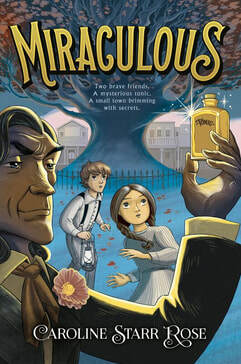 Caroline Starr Rose writes middle grade and picture books that have earned awards through the American Library Association, the Junior Library Guild, ABA New Voices, and more. They've been on the Amazon Best Books of the Month for Kids list and have been Bank Street College of Education Best Books selections.
Caroline Starr Rose writes middle grade and picture books that have earned awards through the American Library Association, the Junior Library Guild, ABA New Voices, and more. They've been on the Amazon Best Books of the Month for Kids list and have been Bank Street College of Education Best Books selections. I recently read Miraculous, the story of thirteen-year-old Jack, who becomes an assistant to Dr. Kingsbury, a traveling medicine salesman. Dr. Kingsbury claims his elixir can cure everything from pimples to hearing loss to a broken heart. Jack believes the claims after Dr. Kingsbury gives a bottle of his “Miraculous Tonic” to him, and it cures his baby sister. But when the medical wagon makes a stop in the town of Oakdale, events happen that cause Jack's faith to waver. Soon, he and his new friend Cora are racing to discover truths that everyone want hidden.
This novel reminded me of Moon Over Manifest and of Tuck Everlasting, both of which have tonics with magical powers that may or may not be all they claim, and which bring about unexpected consequences. It's fast paced and exciting and will keep readers guessing.
Once I finished reading Miraculous, I got the opportunity to ask Caroline Starr Rose some questions, which she graciously answered. I'd like to share her responses with you:
 Why did you choose the 1880s for Miraculous? Honestly, I don’t remember specifically why I chose the 1880s, but I knew I wanted to be well into the traveling medicine show era. Having recently written a book set in 1889-1890 (A Race Around the World: The True Story of Nellie Bly and Elizabeth Bisland), I knew what an exciting era that was as far as innovation goes. (Big cities had electric lights, telephones, skyscrapers, steam engines — all things that would have intrigued my character Cora, a small-town girl interested in experiencing more.)
Why did you choose the 1880s for Miraculous? Honestly, I don’t remember specifically why I chose the 1880s, but I knew I wanted to be well into the traveling medicine show era. Having recently written a book set in 1889-1890 (A Race Around the World: The True Story of Nellie Bly and Elizabeth Bisland), I knew what an exciting era that was as far as innovation goes. (Big cities had electric lights, telephones, skyscrapers, steam engines — all things that would have intrigued my character Cora, a small-town girl interested in experiencing more.)
Why Ohio? I knew I wanted a town where African Americans were part of the fabric of the community. Early on I knew the story would take place in the Mid-West, but it wasn’t until I took my older son on a college trip that I settled on Ohio. On that trip we toured a park where Cincinnati, OH and Covington, KY converged. There were murals showing the history of the area with panels devoted to various industries, moments in history, and individuals. One panel honored an African American man who ran the town sawmill, was a minister, and a city official. I’d found exactly where my character, Mr. Kennedy, belonged (and with him the rest of the town of Oakdale).
Some of your books, like Blue Birds, have female protagonists. Others, like Jasper and the Riddle of Ridley's Mine, have male protagonists. In Miraculous, a number of different characters get to share their voices. Do you find it easier to have a male vs. female protagonist? What differences do you find as you write in different voices? I’m not sure if it’s easier to write one or the other, but I know I sometimes bring biases I’m unaware of to my work. I remember telling my editor early on when we were working on Jasper that I wasn’t sure how to show his emotions since he was a boy (or if he even had a very big range of emotions). She kindly reminded me that, you know, boys are human. They’ve got emotions, too. Of course they do! I felt pretty dumb (and rather disrespectful — sorry, boys!), but it showed me I’d let some unknown assumptions color my writing without even realizing it.
What I try to focus on now (thanks to my editor) is a character’s humanity above all else. How would this particular person feel and react in this particular circumstance? That’s where I start. I let each character lead.
What is the big message you want readers to come away with after reading Miraculous? I’m a bit uncomfortable with the idea of a message. Writing for me is about exploring, a way to make sense of the world. I want readers to come along on the journey and draw their own conclusions. Looking through that lens I’d say I’d love readers to consider the influence and power of persuasive personalities. I’d like them to see that while advertising techniques of the past might seem extreme or less polished than what we see today, there are very many similarities, especially when it comes to playing to our sense of our personal flaws and ways we might “fix” them. I’d like them to consider the power of friendship and forgiveness and second chances, of not being afraid to question and reevaluate.
For more information on Caroline and her books, visit her website.
Would you like a signed copy of Miraculous? Leave a comment below expressing your interest. I'll choose one lucky person and announce their name in my email on Thursday, February 23rd. Jennifer Bohnhoff writes fiction for middle grade through adult readers. Her next book, Summer of the Bombers, will be available in April 2023. You can read more about her and her books at her website.
Published on February 15, 2023 23:00
February 5, 2023
A New Cover for a New Book
Back in the spring of 2000, a controlled burn in the Jemez Mountains jumped its control lines and became a raging wildfire. Known at the Cerro Grande fire, it burned over 400 homes in Los Alamos, New Mexico, shut down the National Laboratory there, and threw life into confusion and chaos for thousands of residents. The news story stuck with me for a long time, haunting my thoughts and leading me to ask a lot of questions. What would it have been like to live through something like that? How would losing one's home affect a family? What about the pets of the people burned out? Was everyone helpful, or did predators also descend on the victims of this fire?
Finally, my thoughts propelled me to write. I began writing Summer of the Bombers in 2014, during November's National Novel Writing challenge. I got a third of the way through, then set it aside. I didn't pick it up again for eight years.
 I usually create a mock-up cover early in the writing process. It helps me think about what I have to say and where the story is going. When I pulled out the manuscript began working on it again last year, I created a cover that had some of the elements of the story in it. Fire. Forest. One of the bombers that dropped fire retardant on the flames, and whose drone became the background music for the entire time that the fire raged. I also included a picture of someone on horseback because that horse and his rider are central to the story.
I usually create a mock-up cover early in the writing process. It helps me think about what I have to say and where the story is going. When I pulled out the manuscript began working on it again last year, I created a cover that had some of the elements of the story in it. Fire. Forest. One of the bombers that dropped fire retardant on the flames, and whose drone became the background music for the entire time that the fire raged. I also included a picture of someone on horseback because that horse and his rider are central to the story.
Does anyone recognize the horse and rider? I took that image from another of my novels!
But while creating a cover to help guide my writing is helpful, what I create isn't professional enough for the published novel itself. A published novel needs a cover that reflects the story and lets the reader know what genre the book is in. Horror covers look very different from Romance covers, and a cover for a middle grade novel must be different from a novel written for adults. Many of my latest covers have been created by a Ukrainian company called Get Covers. I gave the artist a brief synopsis of the story, similar to this copy, which I plan to put on the back cover: When the Forest Service announces a controlled burn to clear dead wood from the National Forest, no one in Alamitos, New Mexico is worried. But the fire goes out of control, burning a path of destruction that threatens everything that fourteen-year-old Margaret “Punkin” Davis holds dear. Her home destroyed, her horse stolen and her family broken apart, she must find the inner strength to rebuild her life one piece at a time or lose everything.
Based on events during the devastating Cerro Grande Fire in May, 2000, one of many wild fires that have raged throughout the Western United States, this is a novel about resilience and self determination.
I also told the artist that Punkin was a redhead and Wildfire, her horse, was a Palomino. The novel is a YA, short for young adult novel, which means that anyone from the sixth or seventh grade on up would be able to read it. Based on that, this is what the artist came up with:
 I showed this cover to my critique group, and they were less than enthusiastic. While the girl is a redhead, the look on her face made them feel that this was a horror novel, and the background was just too grim for them. They wondered if people looking at it might think she'd caused the fire. Was she a firebomber? An arsonist? I went back to the drawing board, looking for a picture of a girl who had more emotion and more of an attachment to her horse. Also, I wanted a bomber in the picture since it was in the title. Maybe that would keep people from thinking that the girl was a firebomber who set forests ablaze! This is what the second attempt at a cover looked like:
I showed this cover to my critique group, and they were less than enthusiastic. While the girl is a redhead, the look on her face made them feel that this was a horror novel, and the background was just too grim for them. They wondered if people looking at it might think she'd caused the fire. Was she a firebomber? An arsonist? I went back to the drawing board, looking for a picture of a girl who had more emotion and more of an attachment to her horse. Also, I wanted a bomber in the picture since it was in the title. Maybe that would keep people from thinking that the girl was a firebomber who set forests ablaze! This is what the second attempt at a cover looked like:  This was closer, but not quite right, either. My critique group thought it looked like the girl's hair was on fire! They also thought the bomber looked pretty toy-like: definitely not the type of plane we'd seen leaving Kirtland Airforce Base with a belly full of slurry. Also, this girl is way fancier than my Punkin. She'd never wear a top like that one! And the horse was not the Palomino I'd written about. I went back to the artist again.
This was closer, but not quite right, either. My critique group thought it looked like the girl's hair was on fire! They also thought the bomber looked pretty toy-like: definitely not the type of plane we'd seen leaving Kirtland Airforce Base with a belly full of slurry. Also, this girl is way fancier than my Punkin. She'd never wear a top like that one! And the horse was not the Palomino I'd written about. I went back to the artist again.
They say the third time's a charm. The artist was able to find a better plane, and make the slurry the orangy-red color that most of us had seen on news clips. She was also able to change Punkin's shirt into something a little more suitable for the character. But she wasn't able to change the horse, or get rid of the model's fingernail polish.
So the mountain came to Mohammed. I contacted my rancher friend (whose help with the horsey and cow scenes in my books has been invaluable!) who could tell me that the horse in the picture was a bay. I changed the story to make my horse a bay, and I added a scene where another character talked Punkin into trying nail polish. It's funny, the things we have to do as writers!
Here is the final cover (minus the back copy.) What do you think?
Finally, my thoughts propelled me to write. I began writing Summer of the Bombers in 2014, during November's National Novel Writing challenge. I got a third of the way through, then set it aside. I didn't pick it up again for eight years.
 I usually create a mock-up cover early in the writing process. It helps me think about what I have to say and where the story is going. When I pulled out the manuscript began working on it again last year, I created a cover that had some of the elements of the story in it. Fire. Forest. One of the bombers that dropped fire retardant on the flames, and whose drone became the background music for the entire time that the fire raged. I also included a picture of someone on horseback because that horse and his rider are central to the story.
I usually create a mock-up cover early in the writing process. It helps me think about what I have to say and where the story is going. When I pulled out the manuscript began working on it again last year, I created a cover that had some of the elements of the story in it. Fire. Forest. One of the bombers that dropped fire retardant on the flames, and whose drone became the background music for the entire time that the fire raged. I also included a picture of someone on horseback because that horse and his rider are central to the story.Does anyone recognize the horse and rider? I took that image from another of my novels!
But while creating a cover to help guide my writing is helpful, what I create isn't professional enough for the published novel itself. A published novel needs a cover that reflects the story and lets the reader know what genre the book is in. Horror covers look very different from Romance covers, and a cover for a middle grade novel must be different from a novel written for adults. Many of my latest covers have been created by a Ukrainian company called Get Covers. I gave the artist a brief synopsis of the story, similar to this copy, which I plan to put on the back cover: When the Forest Service announces a controlled burn to clear dead wood from the National Forest, no one in Alamitos, New Mexico is worried. But the fire goes out of control, burning a path of destruction that threatens everything that fourteen-year-old Margaret “Punkin” Davis holds dear. Her home destroyed, her horse stolen and her family broken apart, she must find the inner strength to rebuild her life one piece at a time or lose everything.
Based on events during the devastating Cerro Grande Fire in May, 2000, one of many wild fires that have raged throughout the Western United States, this is a novel about resilience and self determination.
I also told the artist that Punkin was a redhead and Wildfire, her horse, was a Palomino. The novel is a YA, short for young adult novel, which means that anyone from the sixth or seventh grade on up would be able to read it. Based on that, this is what the artist came up with:

 I showed this cover to my critique group, and they were less than enthusiastic. While the girl is a redhead, the look on her face made them feel that this was a horror novel, and the background was just too grim for them. They wondered if people looking at it might think she'd caused the fire. Was she a firebomber? An arsonist? I went back to the drawing board, looking for a picture of a girl who had more emotion and more of an attachment to her horse. Also, I wanted a bomber in the picture since it was in the title. Maybe that would keep people from thinking that the girl was a firebomber who set forests ablaze! This is what the second attempt at a cover looked like:
I showed this cover to my critique group, and they were less than enthusiastic. While the girl is a redhead, the look on her face made them feel that this was a horror novel, and the background was just too grim for them. They wondered if people looking at it might think she'd caused the fire. Was she a firebomber? An arsonist? I went back to the drawing board, looking for a picture of a girl who had more emotion and more of an attachment to her horse. Also, I wanted a bomber in the picture since it was in the title. Maybe that would keep people from thinking that the girl was a firebomber who set forests ablaze! This is what the second attempt at a cover looked like:  This was closer, but not quite right, either. My critique group thought it looked like the girl's hair was on fire! They also thought the bomber looked pretty toy-like: definitely not the type of plane we'd seen leaving Kirtland Airforce Base with a belly full of slurry. Also, this girl is way fancier than my Punkin. She'd never wear a top like that one! And the horse was not the Palomino I'd written about. I went back to the artist again.
This was closer, but not quite right, either. My critique group thought it looked like the girl's hair was on fire! They also thought the bomber looked pretty toy-like: definitely not the type of plane we'd seen leaving Kirtland Airforce Base with a belly full of slurry. Also, this girl is way fancier than my Punkin. She'd never wear a top like that one! And the horse was not the Palomino I'd written about. I went back to the artist again. They say the third time's a charm. The artist was able to find a better plane, and make the slurry the orangy-red color that most of us had seen on news clips. She was also able to change Punkin's shirt into something a little more suitable for the character. But she wasn't able to change the horse, or get rid of the model's fingernail polish.
So the mountain came to Mohammed. I contacted my rancher friend (whose help with the horsey and cow scenes in my books has been invaluable!) who could tell me that the horse in the picture was a bay. I changed the story to make my horse a bay, and I added a scene where another character talked Punkin into trying nail polish. It's funny, the things we have to do as writers!
Here is the final cover (minus the back copy.) What do you think?

Published on February 05, 2023 03:14
February 1, 2023
A Sweet Book for Valentines Day
 Although Saint Valentine's Day is not a public holiday in any country, it is a significant cultural and commercial celebration of romance and love. Observed on February 14, it generates millions of dollars in chocolate, flower, and card sales.
Although Saint Valentine's Day is not a public holiday in any country, it is a significant cultural and commercial celebration of romance and love. Observed on February 14, it generates millions of dollars in chocolate, flower, and card sales.Originally, Saint Valentine’s Day recognized the martyrdom of a third century Roman priest who was executed in 269. One legend says that he was killed for performing weddings for Christian soldiers who were forbidden to marry. Another is that, while being jailed for his faith, he restored the sight of the jailer’s blind daughter, to whom he wrote a letter which he signed "Your Valentine" before he was executed.
Regardless of why and how it started, Valentine’s is a day that causes a lot of stress. This is especially true for middle grade students, who feel they are too old for the silliness of elementary school Valentines Parties, yet aren’t confident in matters of the heart.
Hector “Hec” Anderson is a good example of a middle grader blundering his way through first love. An awkward, geeky sixth grade boy, Hec finds himself speechless when a new girl, Sandy Richardson, enrolls in his school. Sandy is beautiful and kind and Hec is instantly smitten with her. Unfortunately, so is the tall, handsome and popular captain of the basketball team, who sics his goons on Hec in an attempt to intimidate him.
The Valentine’s Day Dance is coming up. Hec tries to get Sandy’s with flowers and candy, but everything he does turns into a disaster. Does he dare ask her to dance with him – and earn a chance to win her heart?
Tweet Sarts, the Valentines-themed middle grade novel in the Anderson Chronicles series, is for middle grade readers and older readers who remember the difficulties of young love.
 Jennifer Bohnhoff taught middle school for years. She is now a full time writer of books for middle grade through adult readers.
Jennifer Bohnhoff taught middle school for years. She is now a full time writer of books for middle grade through adult readers. Tweet Sarts is onsale to download onto an ereader from Amazon from February 2-9 for only .99. Rather have a signed copy sent direct from the author? You can do that here.
Published on February 01, 2023 23:00
January 25, 2023
Sweets for the Sweet
 Valentine's Day is growing near, and for the Anderson family, that spells complications. Dad's long work hours makes Mom trade in her no- nonsense pony tail and sweatpants for capris and curlers. Big sister Chloe, who believes that Valentine's day is just an excuse for crass consumerism, abandons her principles and her black Goth style for pretty pinks after getting roses from an anonymous admirer. Much to his consternation, little brother Calvin's hand puppet, Mr. Buttons, falls in love. Only the youngest member of the family, Stevie, seems san as he anticipates the sweet tarts and lollypops he'll be getting at preschool,.
Valentine's Day is growing near, and for the Anderson family, that spells complications. Dad's long work hours makes Mom trade in her no- nonsense pony tail and sweatpants for capris and curlers. Big sister Chloe, who believes that Valentine's day is just an excuse for crass consumerism, abandons her principles and her black Goth style for pretty pinks after getting roses from an anonymous admirer. Much to his consternation, little brother Calvin's hand puppet, Mr. Buttons, falls in love. Only the youngest member of the family, Stevie, seems san as he anticipates the sweet tarts and lollypops he'll be getting at preschool,. For Hec Anderson, a geeky sixth grader, is so inept when it comes to love that he feels like a sci-fi visitor abandoned on an alien world. All of Hec's confusion reaches a crisis point when the girl of his dreams moves to town and he must challenge the most popular boy in school for her attention at the school dance.
When Hec learns that Sandy loves polka dots, he decides that M&Ms are the way to her heart. Sandy reciprocates, giving Hec a bag of M&M-studded cookies, which he resolves to keep forever. Forever ends up being a very short period of time, and the cookies end up being eaten: by whom, I won't tell you. But if you'd like some of your own to eat, here's a recipe.
Polka Dot Cookies 3/4 cup firmly packed brown sugar
1/2 cup butter, at room temperature
1/2 cup shortening
2 tsp vanilla
1 egg
1 3/4 cup flour
1 tsp baking soda
1/2 tsp salt
1 cup candy-coated chocolate pieces
Heat oven to 350°
In a large bowl, beat brown sugar, butter and shortening until light and fluffy.
Add vanilla and egg and blend well.
Stir in flour, baking soda and salt.
Stir in chocolate pieces.
Cover with plastic wrap and refrigerate for easier handling.
Shape into 2" balls and place 4" apart on an ungreased cookie sheet.
You can press an additional 1/2 cup candy into balls to decorate tops of cookies.
Bake for 15-20 minutes, or until light golden brown. Cool 2 minutes before removing from sheets and placing on a cooling rack. Makes 14 large cookies
 If you'd like to read something sweet this Valentine's season, Tweet Sarts is available in paperback and e-reader formats from many online books stores. You can also purchase a signed copy dedicated to the one your love directly from the author. She is selling this book at a discount between now and Valentine's day because she loves her readers.
If you'd like to read something sweet this Valentine's season, Tweet Sarts is available in paperback and e-reader formats from many online books stores. You can also purchase a signed copy dedicated to the one your love directly from the author. She is selling this book at a discount between now and Valentine's day because she loves her readers.
Published on January 25, 2023 23:00
January 21, 2023
New Mexico Strange: The PHOENICIAN Stone
I am blessed to be in a women's hiking group. We meet once a week and go a lot of interesting places. Since we all live in the greater Albuquerque area, most of or hikes are in or around the Sandia Mountains, the mountains that are in the background of this blog's header. Right now, most of our favorite trails are under a foot or more of snow. While we do use snowshoes on occasion, often we use the snowy season to go other places. One of the places we hiked this month was to see the Phoenician Stone, which is sometimes called the Decalogue Stone. Located at the base of a basalt- covered uplift about 35 miles southwest of Albuquerque and 15 miles west of Los Lunas, it is off the beaten track but well worth seeing if you are into curiosities and strange stories.  The Decalogue Stone was first mentioned by Frank Hibben (1910-2002), who was then an archaeology professor at the University of New Mexico. Hibben claimed that he was taken to the site in 1933, guided by a man who said he'd seen the stone as a boy back in the 1880s. Hibben was convinced that the inscription was ancient, and thus authentic. Some scholars have said that the writing is ancient Hebrew and is of the ten commandments, which is why it is sometimes called the Decalogue Stone. Others have announced that the writing is Phoenician and is an account of a shipwrecked sailor wandering in the desert. It's also been called Mystery Rock and the Los Lunas Inscription Stone. Some believe that it is a forgery created by members of the Mormon Battalion, who came through New Mexico during the Mexican–American War of 1846–1848. Others believe that Hibben or a couple of his graduate assistants created the stone. And, like most strange things in New Mexico, others suppose it is a record of aliens from outer space.
The Decalogue Stone was first mentioned by Frank Hibben (1910-2002), who was then an archaeology professor at the University of New Mexico. Hibben claimed that he was taken to the site in 1933, guided by a man who said he'd seen the stone as a boy back in the 1880s. Hibben was convinced that the inscription was ancient, and thus authentic. Some scholars have said that the writing is ancient Hebrew and is of the ten commandments, which is why it is sometimes called the Decalogue Stone. Others have announced that the writing is Phoenician and is an account of a shipwrecked sailor wandering in the desert. It's also been called Mystery Rock and the Los Lunas Inscription Stone. Some believe that it is a forgery created by members of the Mormon Battalion, who came through New Mexico during the Mexican–American War of 1846–1848. Others believe that Hibben or a couple of his graduate assistants created the stone. And, like most strange things in New Mexico, others suppose it is a record of aliens from outer space.  Whatever its provenance, going to see it was a great thing to do on a cold, January day! We left our cars outside the Valencia County Landfill and hiked in over a dirt ranch road until we got to the base of Hidden Mountain, where we turned and walked up a ravine until we got to the stone. In the picture below, the stone is on the left, right in front of the woman on the far left.
Whatever its provenance, going to see it was a great thing to do on a cold, January day! We left our cars outside the Valencia County Landfill and hiked in over a dirt ranch road until we got to the base of Hidden Mountain, where we turned and walked up a ravine until we got to the stone. In the picture below, the stone is on the left, right in front of the woman on the far left. 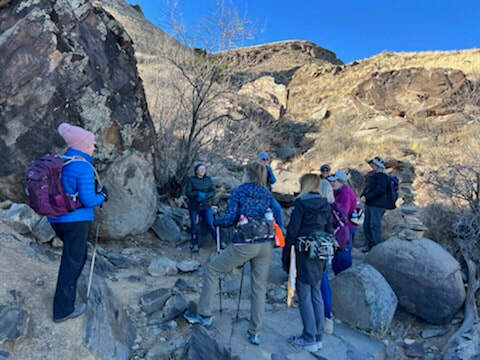 The stone may be a hoax, but what's on the top of Hidden Mountain isn't. After a scramble up a ravine, we arrived on top, where we found a lot of petroglyphs and the ruins of an ancient settlement that might have been part of a string of look-out and way stations along an ancient trail from the Rio Grande to Acoma Pueblo. Also in the area is the Franklin Pottery Mound, where a large diversity of ancient pottery has been unearthed. Both the mound and the ruins are believed to be from between 1350 and 1500. It's pretty obvious why this site would be chosen as a look-out. The views were spectacular in all four directions. We even saw a small herd of deer (although some of us thought they were pronghorns) down below.
The stone may be a hoax, but what's on the top of Hidden Mountain isn't. After a scramble up a ravine, we arrived on top, where we found a lot of petroglyphs and the ruins of an ancient settlement that might have been part of a string of look-out and way stations along an ancient trail from the Rio Grande to Acoma Pueblo. Also in the area is the Franklin Pottery Mound, where a large diversity of ancient pottery has been unearthed. Both the mound and the ruins are believed to be from between 1350 and 1500. It's pretty obvious why this site would be chosen as a look-out. The views were spectacular in all four directions. We even saw a small herd of deer (although some of us thought they were pronghorns) down below. 


 There's something wonderful and a bit eerie about being in a place that was occupied hundreds of years ago. It makes me wonder what life might have been like back then. What did the people who lived there feel as they stood on the edge and looked out over the vastness?
There's something wonderful and a bit eerie about being in a place that was occupied hundreds of years ago. It makes me wonder what life might have been like back then. What did the people who lived there feel as they stood on the edge and looked out over the vastness?
After we'd walked the whole upper portion, we went back down the ravine and had a little celebration. Two of us (including yours truly) had birthdays to celebrate.
 It's not often one gets to celebrate her birthday at a landfill! My friends take me to the best places! No kidding, I can truly say that it was a wonderful experience.
It's not often one gets to celebrate her birthday at a landfill! My friends take me to the best places! No kidding, I can truly say that it was a wonderful experience.
Will this ever work itself into one of my books? Probably not. But it was a wonderful experience anyway.
Jennifer Bohnhoff lives in the mountains of central New Mexico. She has written a number of novels for middle grade through adult readers and has two titles that will be published in 2023. Click here to join her email list and receive information about her books.
 The Decalogue Stone was first mentioned by Frank Hibben (1910-2002), who was then an archaeology professor at the University of New Mexico. Hibben claimed that he was taken to the site in 1933, guided by a man who said he'd seen the stone as a boy back in the 1880s. Hibben was convinced that the inscription was ancient, and thus authentic. Some scholars have said that the writing is ancient Hebrew and is of the ten commandments, which is why it is sometimes called the Decalogue Stone. Others have announced that the writing is Phoenician and is an account of a shipwrecked sailor wandering in the desert. It's also been called Mystery Rock and the Los Lunas Inscription Stone. Some believe that it is a forgery created by members of the Mormon Battalion, who came through New Mexico during the Mexican–American War of 1846–1848. Others believe that Hibben or a couple of his graduate assistants created the stone. And, like most strange things in New Mexico, others suppose it is a record of aliens from outer space.
The Decalogue Stone was first mentioned by Frank Hibben (1910-2002), who was then an archaeology professor at the University of New Mexico. Hibben claimed that he was taken to the site in 1933, guided by a man who said he'd seen the stone as a boy back in the 1880s. Hibben was convinced that the inscription was ancient, and thus authentic. Some scholars have said that the writing is ancient Hebrew and is of the ten commandments, which is why it is sometimes called the Decalogue Stone. Others have announced that the writing is Phoenician and is an account of a shipwrecked sailor wandering in the desert. It's also been called Mystery Rock and the Los Lunas Inscription Stone. Some believe that it is a forgery created by members of the Mormon Battalion, who came through New Mexico during the Mexican–American War of 1846–1848. Others believe that Hibben or a couple of his graduate assistants created the stone. And, like most strange things in New Mexico, others suppose it is a record of aliens from outer space.  Whatever its provenance, going to see it was a great thing to do on a cold, January day! We left our cars outside the Valencia County Landfill and hiked in over a dirt ranch road until we got to the base of Hidden Mountain, where we turned and walked up a ravine until we got to the stone. In the picture below, the stone is on the left, right in front of the woman on the far left.
Whatever its provenance, going to see it was a great thing to do on a cold, January day! We left our cars outside the Valencia County Landfill and hiked in over a dirt ranch road until we got to the base of Hidden Mountain, where we turned and walked up a ravine until we got to the stone. In the picture below, the stone is on the left, right in front of the woman on the far left.  The stone may be a hoax, but what's on the top of Hidden Mountain isn't. After a scramble up a ravine, we arrived on top, where we found a lot of petroglyphs and the ruins of an ancient settlement that might have been part of a string of look-out and way stations along an ancient trail from the Rio Grande to Acoma Pueblo. Also in the area is the Franklin Pottery Mound, where a large diversity of ancient pottery has been unearthed. Both the mound and the ruins are believed to be from between 1350 and 1500. It's pretty obvious why this site would be chosen as a look-out. The views were spectacular in all four directions. We even saw a small herd of deer (although some of us thought they were pronghorns) down below.
The stone may be a hoax, but what's on the top of Hidden Mountain isn't. After a scramble up a ravine, we arrived on top, where we found a lot of petroglyphs and the ruins of an ancient settlement that might have been part of a string of look-out and way stations along an ancient trail from the Rio Grande to Acoma Pueblo. Also in the area is the Franklin Pottery Mound, where a large diversity of ancient pottery has been unearthed. Both the mound and the ruins are believed to be from between 1350 and 1500. It's pretty obvious why this site would be chosen as a look-out. The views were spectacular in all four directions. We even saw a small herd of deer (although some of us thought they were pronghorns) down below. 


 There's something wonderful and a bit eerie about being in a place that was occupied hundreds of years ago. It makes me wonder what life might have been like back then. What did the people who lived there feel as they stood on the edge and looked out over the vastness?
There's something wonderful and a bit eerie about being in a place that was occupied hundreds of years ago. It makes me wonder what life might have been like back then. What did the people who lived there feel as they stood on the edge and looked out over the vastness? After we'd walked the whole upper portion, we went back down the ravine and had a little celebration. Two of us (including yours truly) had birthdays to celebrate.

 It's not often one gets to celebrate her birthday at a landfill! My friends take me to the best places! No kidding, I can truly say that it was a wonderful experience.
It's not often one gets to celebrate her birthday at a landfill! My friends take me to the best places! No kidding, I can truly say that it was a wonderful experience. Will this ever work itself into one of my books? Probably not. But it was a wonderful experience anyway.
Jennifer Bohnhoff lives in the mountains of central New Mexico. She has written a number of novels for middle grade through adult readers and has two titles that will be published in 2023. Click here to join her email list and receive information about her books.
Published on January 21, 2023 23:00
January 18, 2023
WildFires in New Mexico
 On the Parjarito Plateau, a volcanic plateau in the Jemez Mountains of north central New Mexico, large fires used to occur about every twenty years, following a natural climate cycle. Years of heavy rains and deep snows would lead to luxuriant growth of new trees and undergrowth, which would become natural fuel during drought years. Lately, the frequency and intensity of fires has increased, and so have their damage. Some of these fires have begun naturally, most frequently from lightning strikes. Others have been started by irresponsible people who've thrown a cigarette butt out the window of a moving car or left a campfire smoldering. The latest and most destrucive have begun as controlled burns that overstepped their bounds. Here are some of the most notable of the past eighty years. The first time a fire led to the evacuation of Los Alamos laboratories was in 1954. The Water Canyon Fire began as a trash and construction debris burn on June 5, 1954. High winds, including gusts up to 45 mph pushed the fire north. It burned out of control for several days before 1,000 firefighters and a drop in wind speed slowed it down. Between 3,000 and 6,000 acres of forest were lost.
On the Parjarito Plateau, a volcanic plateau in the Jemez Mountains of north central New Mexico, large fires used to occur about every twenty years, following a natural climate cycle. Years of heavy rains and deep snows would lead to luxuriant growth of new trees and undergrowth, which would become natural fuel during drought years. Lately, the frequency and intensity of fires has increased, and so have their damage. Some of these fires have begun naturally, most frequently from lightning strikes. Others have been started by irresponsible people who've thrown a cigarette butt out the window of a moving car or left a campfire smoldering. The latest and most destrucive have begun as controlled burns that overstepped their bounds. Here are some of the most notable of the past eighty years. The first time a fire led to the evacuation of Los Alamos laboratories was in 1954. The Water Canyon Fire began as a trash and construction debris burn on June 5, 1954. High winds, including gusts up to 45 mph pushed the fire north. It burned out of control for several days before 1,000 firefighters and a drop in wind speed slowed it down. Between 3,000 and 6,000 acres of forest were lost.  Archaeologists walk in front of bulldozers in an attempt to preserve and protect indigenous and early sites during the La Mesa fire. On June 16 1977, the La Mesa fire began. It took a week and over 1,300 personnel to contain the fire that investigators believe began with a spark from a motorcycle. The fire reached K-site and S-site, two facilities in Los Alamos National Laboratory used to fabricate and test chemical explosives, and burned 15,444 acres of Bandelier National Monument. Approximately 60% of the drainage basin of Rio de Los Frijoles, a tributary of the Rio Grande, was burned, leading to severe erosion when the monsoons began later that summer.
Archaeologists walk in front of bulldozers in an attempt to preserve and protect indigenous and early sites during the La Mesa fire. On June 16 1977, the La Mesa fire began. It took a week and over 1,300 personnel to contain the fire that investigators believe began with a spark from a motorcycle. The fire reached K-site and S-site, two facilities in Los Alamos National Laboratory used to fabricate and test chemical explosives, and burned 15,444 acres of Bandelier National Monument. Approximately 60% of the drainage basin of Rio de Los Frijoles, a tributary of the Rio Grande, was burned, leading to severe erosion when the monsoons began later that summer.
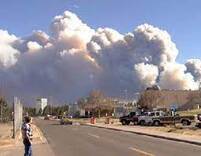 The Dome Fire, seen from Los Alamos In 1996, the Dome Fire began on April 26, when two campers left a campfire burning. By the time it was controlled, it had burned over 16,500 acres and threatened the southern section of Los Alamos National Laboratory. Large areas of Capulin Canyon and the Dome Wilderness were charred. The fire sent flames hundreds of feet into the air and developed a spectacular plume that could be seen for miles. Over 800 firefighters fought this blaze.
The Dome Fire, seen from Los Alamos In 1996, the Dome Fire began on April 26, when two campers left a campfire burning. By the time it was controlled, it had burned over 16,500 acres and threatened the southern section of Los Alamos National Laboratory. Large areas of Capulin Canyon and the Dome Wilderness were charred. The fire sent flames hundreds of feet into the air and developed a spectacular plume that could be seen for miles. Over 800 firefighters fought this blaze.
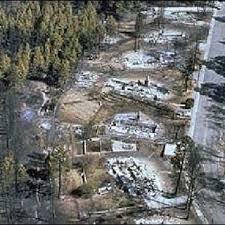 Two years after that, the Cerro Grande Fire began in May 2000 as a controlled burn that was supposed to reduce fire danger in Bandelier National Monument. High winds and dry conditions led the fire to jump its bounds. The fire destroyed over 400 homes in Los Alamos and damaged or destroyed several structures at Los Alamos National Laboratory. Over 43,000-acres were charred.
Two years after that, the Cerro Grande Fire began in May 2000 as a controlled burn that was supposed to reduce fire danger in Bandelier National Monument. High winds and dry conditions led the fire to jump its bounds. The fire destroyed over 400 homes in Los Alamos and damaged or destroyed several structures at Los Alamos National Laboratory. Over 43,000-acres were charred. 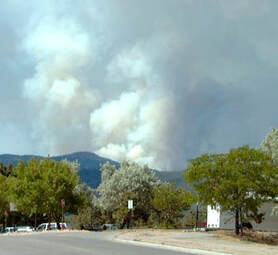 Two years later, the Oso Complex Fire was intentionally started by a man as a protest against government officials whom he claimed were using environmental laws to displace the poor, Hispanic population. Begun on June 20, 1998, the fire burned 5,185 acres of National Forest, including over 1,200 acres owned by Santa Clara Pueblo. It came within 8 miles of Los Alamos before rains and over 800 fire fighters, many of whom were Native Americans, were able to stop it. The arsonist pled guilty and was given a seven-year sentence in federal prison.
Two years later, the Oso Complex Fire was intentionally started by a man as a protest against government officials whom he claimed were using environmental laws to displace the poor, Hispanic population. Begun on June 20, 1998, the fire burned 5,185 acres of National Forest, including over 1,200 acres owned by Santa Clara Pueblo. It came within 8 miles of Los Alamos before rains and over 800 fire fighters, many of whom were Native Americans, were able to stop it. The arsonist pled guilty and was given a seven-year sentence in federal prison. When it happened in 2011, the Las Conchas Fire was the largest wildfire the state of New Mexico had ever seen. It began on June 26, 2011 when an old, dead aspen tree blew into a power line. Driven by strong and unpredictable winds, the fire burned more than 150,000 acres of Pajarito Plateau and threatened the Pajarito Mountain Ski Area, the town of Cochiti, Los Alamos, and Santa Clara Pueblo. It was surpassed in 2012 by the much larger Whitewater-Baldy Complex Fire and in 2022 by the Calf Canyon/Hermits Peak Fire and the Black Fire.
When it happened in 2011, the Las Conchas Fire was the largest wildfire the state of New Mexico had ever seen. It began on June 26, 2011 when an old, dead aspen tree blew into a power line. Driven by strong and unpredictable winds, the fire burned more than 150,000 acres of Pajarito Plateau and threatened the Pajarito Mountain Ski Area, the town of Cochiti, Los Alamos, and Santa Clara Pueblo. It was surpassed in 2012 by the much larger Whitewater-Baldy Complex Fire and in 2022 by the Calf Canyon/Hermits Peak Fire and the Black Fire. The 2022 Calf Canyon/Hermits Peak Fire burned 341,471 acres and blazed from early April to late June. This fire, was in the southern Sangre de Cristo Mountains, and not on Parjarito Plateau. Part of the record-breaking 2022 wildfire season, it was the largest wildfire of 2022 in the contiguous United States and destroyed or damaged nearly a thousand structures, including several hundred homes. The fire began as two separate wildfires, both of which were U.S. Forest Service prescribed burns. It was not fully contained until August 21.
However they are started, wildfires in New Mexico cause terrible damage and stress to its residents, who live in fear both for their property and their lives. As climate change dries out the forests, we must all be even more vigilant.
 Jennifer Bohnhoff is a former English and history teacher who lives in a remote spot in the mountains of central New Mexico.The local fire department has told her that her own house is unlikely to be saved in a wildfire.
Jennifer Bohnhoff is a former English and history teacher who lives in a remote spot in the mountains of central New Mexico.The local fire department has told her that her own house is unlikely to be saved in a wildfire. Her next novel, Summer of the Bombers, will be released in April 2023. Set in the fictitious town of Alamitos, it tells the story of a young woman whose life becomes chaotic after a controlled burn goes rogue and destroys her house. It is based loosely on the Cerro Grande fire of 2000.
You can read more about her and her books here.
Published on January 18, 2023 23:00
January 16, 2023
Kozlowski's Ranch: Important Site in the Battle of Glorieta
 The decisive battle in the Confederacy's attempt to take New Mexico during the Civil War took place on March 26-28, 1862. Called the Battle of Glorieta, or the Battle of Glorieta Pass, it ranged through a narrow mountain pass that was the last leg of the Old Santa Fe Trail before it reached Santa Fe. Three ranches, owned by three very different characters, were settings for this battle.
The decisive battle in the Confederacy's attempt to take New Mexico during the Civil War took place on March 26-28, 1862. Called the Battle of Glorieta, or the Battle of Glorieta Pass, it ranged through a narrow mountain pass that was the last leg of the Old Santa Fe Trail before it reached Santa Fe. Three ranches, owned by three very different characters, were settings for this battle.
 Martin Kozlowski came to the area by a circuitous route. He was born in Warsaw, Poland in 1827 and fought in the 1848 revolution against the Prussians. He was a refugee for two years in England, during which time he met and married an Irish woman named Ellene. The two immigrated to American in 1853, and Martin enlisted in the First Dragoons, who were fighting Apaches in the Southwest.
Martin Kozlowski came to the area by a circuitous route. He was born in Warsaw, Poland in 1827 and fought in the 1848 revolution against the Prussians. He was a refugee for two years in England, during which time he met and married an Irish woman named Ellene. The two immigrated to American in 1853, and Martin enlisted in the First Dragoons, who were fighting Apaches in the Southwest.Martin must have fallen in love with New Mexico during his Army years. In 1858 he mustered out and used his 160-acre government bounty land warrant to purchase the land on the far eastern edge of Glorieta Pass. Here, the Pecos River meets Glorieta Stream in a wide, flat area that is well watered and has fertile soil. Kozlowski's 600 acre spread included 50 improved acres, which consisted of a home for the family, a trading post, a tavern, and rooms for travelers. It had a spring for fresh water, and lots of forage for horses and mules. The 1860 agriculture census shows that Kozlowski grew corn and raised livestock, but a lot of his livelihood came from accommodating for travelers on the Santa Fe trail.
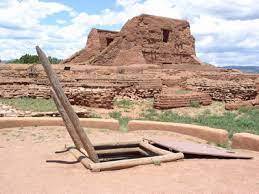 The Spanish mission church at Pecos Pueblo. The entrance to a kiva is in the foreground This area had been settled long before the Santa Fe Trail opened. Perhaps the first settlers in the area were the people who founded Pecos Pueblo sometime around AD 1100. Historically known as Cicuye (sometimes spelled Ciquique), which mean the "village of 500 warriors," the Pueblo was visited by the Spanish explorer Francisco Vásquez de Coronado in 1540. The Spanish mission church was built in 1619 and the kiva in 1680, after a revolt that caused the Spanish to abandon the area. In 1838, attacks by Comanches compelled the inhabitants to abandon the area and move in with their relatives at the Walatowa Pueblo in Jemez. Twenty years later, Kozlowski moved to the area and used some of the timbers and bricks from the abandoned pueblo to build his buildings.
The Spanish mission church at Pecos Pueblo. The entrance to a kiva is in the foreground This area had been settled long before the Santa Fe Trail opened. Perhaps the first settlers in the area were the people who founded Pecos Pueblo sometime around AD 1100. Historically known as Cicuye (sometimes spelled Ciquique), which mean the "village of 500 warriors," the Pueblo was visited by the Spanish explorer Francisco Vásquez de Coronado in 1540. The Spanish mission church was built in 1619 and the kiva in 1680, after a revolt that caused the Spanish to abandon the area. In 1838, attacks by Comanches compelled the inhabitants to abandon the area and move in with their relatives at the Walatowa Pueblo in Jemez. Twenty years later, Kozlowski moved to the area and used some of the timbers and bricks from the abandoned pueblo to build his buildings.
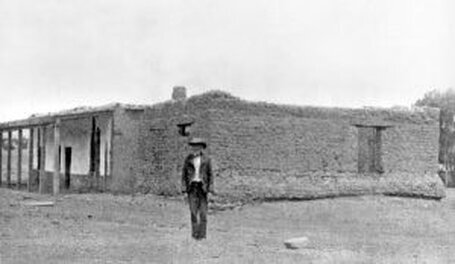 Martin Kozlowski in front of his trading post.
Martin Kozlowski in front of his trading post. 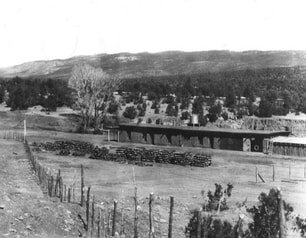 Kozlowski's ranch became site of Camp Lewis, the headquarters for the Union Army during the Battle of Glorieta. The troops were mostly men from Colorado, who had come from Camp Wells in Denver, through Raton Pass, and stopped in Fort Union. Their leader, John Slough, intended to engage the Confederates in Santa Fe and was surprised to encounter Confederate troops in the pass.
Kozlowski's ranch became site of Camp Lewis, the headquarters for the Union Army during the Battle of Glorieta. The troops were mostly men from Colorado, who had come from Camp Wells in Denver, through Raton Pass, and stopped in Fort Union. Their leader, John Slough, intended to engage the Confederates in Santa Fe and was surprised to encounter Confederate troops in the pass. The Union Army continued to maintain a hospital in Kozlowski's tavern for another two months after the battle was over.
After the war, Kozlowski complimented them, saying “When they camped on my place, they never robbed me of anything, not even a chicken.” Perhaps their good behavior was because Kozlowski was former military himself. The early 1870s appear to be the high point for the Kozlowski family's enterprises. In 1873, U.S. Attorney T.B. Catron sued him for violating a federal law that prevented non-Indians from settling on pueblo land grants. The case went all the way to the Supreme Court, but ultimately Martin paid $1,000 and was able to keep his land. In 1880 the Atchison, Topeka, and Santa Fe Railroad ran its line through the canyon, effectively ending the lucrative Santa Fe Trail traffic. Soon thereafter, Kozlowski moved to Albuquerque, where he died in 1905.
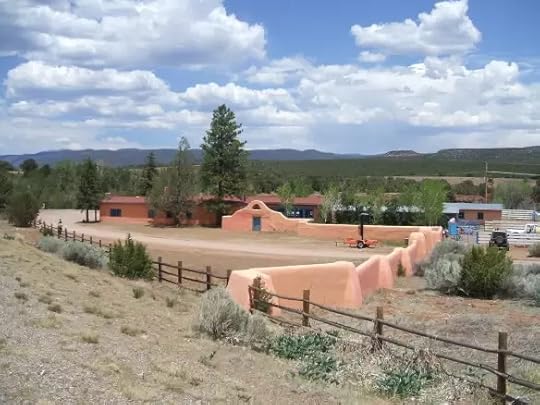 Kozlowski's ranch traded hands several times after he left it. Sometimes, it was a working ranch. At other times, It became a dude ranch where tourists could live like pampered cowboys. In 1939, a Texas oilman and rancher named Buddy Fogelson bought the property and renamed it The Forked Lightning Ranch. Fogelson's widow, the actress Greer Garson, donated the ranch to the National Park Service in 1991. It is now part of Pecos National Park. Kozlowski's Ranch is one of the major settings for The Worst Enemy, which will be published August 15, 2023..
Kozlowski's ranch traded hands several times after he left it. Sometimes, it was a working ranch. At other times, It became a dude ranch where tourists could live like pampered cowboys. In 1939, a Texas oilman and rancher named Buddy Fogelson bought the property and renamed it The Forked Lightning Ranch. Fogelson's widow, the actress Greer Garson, donated the ranch to the National Park Service in 1991. It is now part of Pecos National Park. Kozlowski's Ranch is one of the major settings for The Worst Enemy, which will be published August 15, 2023.. The Worst Enemy is book 2 of Rebels Along the Rio Grande, a trilogy of middle grade historical novels about New Mexico during the Civil War.
Book 1: Where Duty Calls, is available in ebook and paperback.
Published on January 16, 2023 03:28
Pigeon's Ranch: Important Site in the Battle of Glorieta
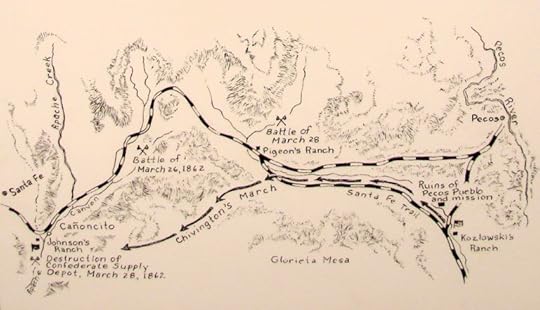 The Battle of Glorieta Pass ranged through a narrow mountain divide in the Sangre de Cristo mountains just east of Santa Fe on March 26-28, 1862. The pass was part of the Santa Fe trail that had connected Old Santa Fe to Franklin, Missouri for nearly half a century. The three ranches involved in the battle were also used as way stops along the trail. Three very different characters owned and operated the ranches.
The Battle of Glorieta Pass ranged through a narrow mountain divide in the Sangre de Cristo mountains just east of Santa Fe on March 26-28, 1862. The pass was part of the Santa Fe trail that had connected Old Santa Fe to Franklin, Missouri for nearly half a century. The three ranches involved in the battle were also used as way stops along the trail. Three very different characters owned and operated the ranches.Union troops were headquartered at a ranch on the eastern end of the pass that was owned by a Polish immigrant named Kozlowski. You can read more about him and his ranch here.
The Confederate base was at Johnson's ranch, located at the western mouth of the canyon.
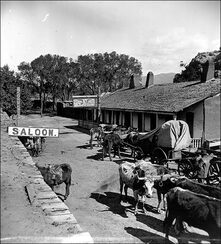 Pigeon's Ranch in the 1880s. Between Kozlowski's and Johnson's place sat Pigeon's ranch, which operated a hotel and saloon and was a popular watering hole along the trail. Pigeon's Ranch was the frequent venue for fandangos, the local dances.
Pigeon's Ranch in the 1880s. Between Kozlowski's and Johnson's place sat Pigeon's ranch, which operated a hotel and saloon and was a popular watering hole along the trail. Pigeon's Ranch was the frequent venue for fandangos, the local dances.Pigeon's ranch was owed by a French immigrant whose very name is a matter of speculation. Some records list him as Alexander Pigeon. Some sources, however, say that Pigeon was a nickname he received because he strutted and flapped his elbows when he danced, making him look rather like a pigeon. On some documents, he is named Alexander Valle. Some historians suggest that Valle is less a surname as a placename given to him because his establishment was in the center of the valley. Both Pigeon and Valle are names that can be found in France, so either may be the man's actual name.
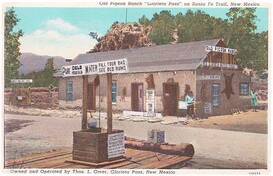 An old postcard showing Pigeon's Ranch. Early in the morning of March 26, a Union scouting party led by Lt. George Nelson encountered and captured a Confederate scouting party near Pigeon's Ranch. The two armies clashed west of the ranch later that day. By nightfall, Union Forces had fallen back to Pigeon's ranch, which had become a hospital for wounded and dying men on both sides. Two days later, the ranch was the center of the battle, its short adobe walls shielding Union soldiers from the oncoming Confederates. In 1986, a mass grave with the skeletons of 31 Confederate soldiers was discovered on the property.
An old postcard showing Pigeon's Ranch. Early in the morning of March 26, a Union scouting party led by Lt. George Nelson encountered and captured a Confederate scouting party near Pigeon's Ranch. The two armies clashed west of the ranch later that day. By nightfall, Union Forces had fallen back to Pigeon's ranch, which had become a hospital for wounded and dying men on both sides. Two days later, the ranch was the center of the battle, its short adobe walls shielding Union soldiers from the oncoming Confederates. In 1986, a mass grave with the skeletons of 31 Confederate soldiers was discovered on the property.
 In this depiction of The Battle of Glorieta Pass by Roy Anderson, Pigeon's Ranch is shown in the background. The Battle of Glorieta Pass is sometimes called 'The Gettys-burg of the West" because it is the battle that marks the farthest north the Confederate Army got in the New Mexico Campaign. Had H.H. Sibley's forces not been turned back here, they might have taken the Colorado gold fields, then turned west and taken the gold and harbors of California, and the Civil War might have ended very differently. But this battle could easily have been called The Battle of Three Ranches because of where it was fought. Jennifer Bohnhoff is an educator and author who lives in the mountains of central New Mexico. The view from her backyard includes the Sangre de Cristo mountains. Part of her novel The Worst Enemy takes place at Pigeon Ranch.
In this depiction of The Battle of Glorieta Pass by Roy Anderson, Pigeon's Ranch is shown in the background. The Battle of Glorieta Pass is sometimes called 'The Gettys-burg of the West" because it is the battle that marks the farthest north the Confederate Army got in the New Mexico Campaign. Had H.H. Sibley's forces not been turned back here, they might have taken the Colorado gold fields, then turned west and taken the gold and harbors of California, and the Civil War might have ended very differently. But this battle could easily have been called The Battle of Three Ranches because of where it was fought. Jennifer Bohnhoff is an educator and author who lives in the mountains of central New Mexico. The view from her backyard includes the Sangre de Cristo mountains. Part of her novel The Worst Enemy takes place at Pigeon Ranch. The Worst Enemy is book 2 of Rebels Along the Rio Grande, a trilogy of middle grade historical novels set in New Mexico during the Civil War. It is scheduled to be published August 15, 2023. .
Published on January 16, 2023 03:28
January 11, 2023
The Cerro Grande Fire
 Fourteen years after the Cerro Grande fire, devastation on the Quemazon Trail west of Los Alamos is still obvious. This image was obtained from http://www.gao.gov/new.items/rc00257t..., a document titled "T-RCED-00-257 Fire Management: Lessons Learned From the Cerro Grande Fire", Public Domain In May of 2000, a disastrous forest fire that came to be named The Cerro Grande Fire began in the hills above the town of Los Alamos, New Mexico. By the time it was contained, it had burned many homes, threatened national security, and destroyed the lives of many people.
Fourteen years after the Cerro Grande fire, devastation on the Quemazon Trail west of Los Alamos is still obvious. This image was obtained from http://www.gao.gov/new.items/rc00257t..., a document titled "T-RCED-00-257 Fire Management: Lessons Learned From the Cerro Grande Fire", Public Domain In May of 2000, a disastrous forest fire that came to be named The Cerro Grande Fire began in the hills above the town of Los Alamos, New Mexico. By the time it was contained, it had burned many homes, threatened national security, and destroyed the lives of many people.The fire started as a controlled burn high on Cerro Grande, a 10,200-foot summit covered with a mix of ponderosa pine, douglas fir, white fir, and aspen trees. The summit, which sits on the rim of the Valles Caldera, has a rincon, or meadow on its southern slopes. The United States Forest Service chose that rincon as the starting place for a controlled burn that was part of a 10-year plan for reducing fire hazard within Bandelier National Monument. That rincon is the headwaters of Frijoles Creek, which flows southeast into the Rio Grande. It is close to New Mexico State Road 4, the main highway through Los Alamos County.
 The smoke from the fire made it all the way to Oklahoma. Public Domain, https://commons.wikimedia.org/w/index... Spring may not be the best time to start controlled burns in the Jemez. High winds are common during this time of year. In addition to that, the forests were extremely dry but filled with undergrowth. In the early-to-mid-1990s, the Jemez had received abnormally high precipitation, leading to an explosion of luxuriant undergrowth. Then, several years of severe drought had dried out the forest. Deadfall, trees that had died and laid on the ground, had a moisture content lower than that of well-cured firewood. Conditions were ideal for a major forest fire. However, officials worried that if controlled burn were not used to clear the forest, a lightning strike or human carelessness could lead to disaster. Officials decided that a controlled burn was safer than letting nature take its course. The burn was scheduled to begin late in the evening of May 4, 2000. Just after the burn had begun, the winds picked up. By May 5th, the fire had burned through its controllines on the east side. The burn was declared a wildfire that afternoon. By May 7th, the fire’s behavior had become increasingly erratic, with spotting, the creation of new fires, due to flying embers, becoming common. Los Alamos National Laboratory shut down operations on May 8. Two days later, the town of Los Alamos was evacuated. That evening, 235 homes in Los Alamos were destroyed.
The smoke from the fire made it all the way to Oklahoma. Public Domain, https://commons.wikimedia.org/w/index... Spring may not be the best time to start controlled burns in the Jemez. High winds are common during this time of year. In addition to that, the forests were extremely dry but filled with undergrowth. In the early-to-mid-1990s, the Jemez had received abnormally high precipitation, leading to an explosion of luxuriant undergrowth. Then, several years of severe drought had dried out the forest. Deadfall, trees that had died and laid on the ground, had a moisture content lower than that of well-cured firewood. Conditions were ideal for a major forest fire. However, officials worried that if controlled burn were not used to clear the forest, a lightning strike or human carelessness could lead to disaster. Officials decided that a controlled burn was safer than letting nature take its course. The burn was scheduled to begin late in the evening of May 4, 2000. Just after the burn had begun, the winds picked up. By May 5th, the fire had burned through its controllines on the east side. The burn was declared a wildfire that afternoon. By May 7th, the fire’s behavior had become increasingly erratic, with spotting, the creation of new fires, due to flying embers, becoming common. Los Alamos National Laboratory shut down operations on May 8. Two days later, the town of Los Alamos was evacuated. That evening, 235 homes in Los Alamos were destroyed.By the time the fire was declared officially contained, on June 6, over 400 families had lost their homes and over 43,000 acres had been burned. Los Alamos National Laboratory suffered from destruction or damage to its structures, but none of the special nuclear material housed there was destroyed or damaged. Luckily, there was no loss of human life. The US General Accounting Office estimated total damages at $1 billion. The Cerro Grande fire was declared extinguished on July 20, 2000.
But even if the fire was no longer threatening Los Alamos, life could not go back to normal. Scientists determined that the soil beneath a layer of ash or burned soil had become hydrophobic, or water repellant. Los Alamos, the laboratory, and the lower parts of the burned area are all situated on the Pajarito Plateau, an area which has a lot of canyons that concentrate surface runoff. When the monsoon rains which usually begin in July occurred, it was highly likely that the hydrophobic soil would result in serious flash flooding. Diamond Drive, one of the town's arterial roads, was damaged in such a flood.
These floods also created serious erosion issues, especially along the 57 miles of trails that had become clogged with fallen trees and boulders washed down from higher elevations. A volunteer task force devoted many thousands of hours to rebuilding trails and planting trees. Local school children made many thousands of "seed balls" to broadcast in the burned areas, and about 7000 hydromulching and hydroseeding flights occurred during the month of July. Water quality had to be monitored for several years after the fire.
 A FEMAville in Greensburg, Kansas photo by Jackie Langholz In order to house people who had been burned out, the Federal Emergency Management Agency (FEMA) brought in portable buildings, or trailers. The trailers weren’t available until June because they not only had to be delivered, but hooked up to municipal utilities that had to be extended out to undeveloped land near the county rodeo grounds on North Mesa. Known locally as FEMAville, the complex housed hundreds of displaced residents. In 2006, when the trailers were removed, most of the displaced residents had been settled into new homes, although reconstruction of houses in the burned area continued for several years after that. Wildfires have grown increasingly common in the years since the Cerro Grande fire, and they continue to be a source of great controversy, especially when they begin through government action.
A FEMAville in Greensburg, Kansas photo by Jackie Langholz In order to house people who had been burned out, the Federal Emergency Management Agency (FEMA) brought in portable buildings, or trailers. The trailers weren’t available until June because they not only had to be delivered, but hooked up to municipal utilities that had to be extended out to undeveloped land near the county rodeo grounds on North Mesa. Known locally as FEMAville, the complex housed hundreds of displaced residents. In 2006, when the trailers were removed, most of the displaced residents had been settled into new homes, although reconstruction of houses in the burned area continued for several years after that. Wildfires have grown increasingly common in the years since the Cerro Grande fire, and they continue to be a source of great controversy, especially when they begin through government action.  Jennifer Bohnhoff is an author of books for middle grade through adult readers. She lives in the fire-prone mountains of central New Mexico. Her next book, Summer of the Bombers, is scheduled to come out on April 10th. The story of a girl who loses both her home and her horse because of a controlled burn gone rampant, it is based loosely on the Cerro Grande fire.
Jennifer Bohnhoff is an author of books for middle grade through adult readers. She lives in the fire-prone mountains of central New Mexico. Her next book, Summer of the Bombers, is scheduled to come out on April 10th. The story of a girl who loses both her home and her horse because of a controlled burn gone rampant, it is based loosely on the Cerro Grande fire.
Published on January 11, 2023 23:00
December 29, 2022
Books about the Great Depression for Middle Grade Readers
My mother in law was raised on a farm in southern Minnesota during the Great Depression. Although her family managed to keep the farm and keep food on the table, she had lots of stories about how they managed to do without much that we now consider essential. Her stories were filled with pride and determination. Many of the stories written for middle schoolers that are set in this period demonstrate the same triumph of the human spirit over adversity, and that makes them good reads and good lessons for today’s youth.
Wish Upon a Crawdad By Curtis Condon
By Curtis Condon
Twelve-year-old Ruby Mae Ryan is determined to make enough money by selling crawdads to the local restaurant and through other odd jobs to buy something very special that she’s kept a secret from everyone but her Daddy and her best friend, Virginia. Set in 1940 in rural Oregon, this story tells what it was like in a time before electric cooperatives brought power to the rural farm country. Full of Beans by Jennifer L. Holm
by Jennifer L. Holm
Bean lives in Key West, Florida with his mother and baby brother. His dad is off somewhere, trying to find work. Two men come to Key West: a government agent trying to renovate Key West as part of the New Deal Plan, and a con man who hires Bean for a few assignments. Bean is torn between wanting the money for his family and knowing that he's involved in questionable work. Bean and his gang of barefooted boys know that the adults are lying about something, but what is it? No Promises in the Wind
 by Irene Hunt
by Irene Hunt
This story from the Newbery Award-winning author of Across Five Aprils and Up a Road Slowly tells the story of Josh, a 15-year-old boy who takes his younger brother on a cross country trek to find a safe place, away from his father’s anger. A talented pianist, he is lucky to find many sympathetic and kind people to help. Even then, the boys come close to death as they struggle to find food and shelter. Al Capone Does My Shirts by Gennifer Choldenko
by Gennifer Choldenko
This book, a Newbery honoree, is the story of Moose, a 12-year-old whose father is a prison-guard on Alcatraz Island. Moose’s sister goes to a special school in San Francisco for help with her autism, and Moose finds it hard to live in the isolation of the island prison, even if it does lead to some very funny scenes. Esperanza Rising
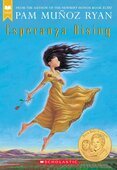 by Pam Muñoz Ryan
by Pam Muñoz Ryan
Another Newberry winter, this book tells the story of Esperanza, who leaves a privileged and comfortable life in Mexico to work with her mom in Southern California labor camps. The tragedy that forced them to leave wealth and ease at home for a new and harsh life as exploited farm workers during the Great Depression will open reader's eyes to a little-known bit of history.
A Long Way from Chicago
 by Richard Peck
by Richard Peck
Siblings Joey and Mary Alice, leave Chicago every summer to spend time with their grandmother in rural Illinois. This book tells stories about their visits from 1929 to 1942. There’s eccentric grandmother makes sure that every trip is memorable, and you will sense the love and laugh a lot about their adventures. The Truth About Sparrows by Marian Hale
by Marian Hale
Even though the drought is making her family’s life impossible, twelve-year-old Sadie Wynn doesn’t want to abandon the only life she’s known and leave her friends in Missouri to move with her family to Texas. This story will help middle grade readers connect with the past, for while times and circumstances change, families and children remain essentially the same. Moon Over Manifest
 by Clare Vanderpool
by Clare Vanderpool
Abilene Tucker has lived an itinerant life. Twelve years old in 1936, her father finds a railroad job, and puts Abilene on a train to go live with relatives. But the curious, intrepid Abilene hops off the rails in Manifest, Kansas — her dad’s hometown — in an effort to find out more about his life. She meets a host of strangers and soon-to-be friends in this strange and downbeat town with a rich and interesting past. Nothing to Fear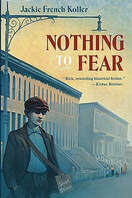 by Jackie French Koller
by Jackie French Koller
Thirteen-year-old Danny becomes the man of the house when his father leaves home in search of work. This story, set in New York City during the Depression, warms the heart as Danny strives to remain a regular kid while being forced into the very adult role of supporting his pregnant mother and younger sister. Out of the Dust
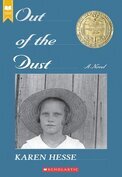 by Karen Hesse
by Karen Hesse
Beautiful and evocative, this Newbery Medal-winning novel-in-verse tells the story of Billie Jo, a fourteen-year-old growing up in the dust bowls of Oklahoma. When terrible accident destroys her family and scars her hands, her one consolation, playing the piano, is taken from her and she must find a way to continue on without it.
Roll of Thunder, Hear My Cry by Mildred D. Taylor
by Mildred D. Taylor
Part of her Logan family series, this Newbery winning novel tells the story of nine-year-old Cassie Logan, the daughter of an African-American farmer in 1930s Mississippi. The novel explores Jim Crow segregation, Black ownership of land vs. sharecropping, and lynching, and is a painful reminder of the tenuousness of black/white relations.
Did I miss your favorite middle grade novel about the Great Depression? Let me know and I'll add it to my list! A former middle school teacher, Jennifer Bohnhoff has written several historical novels for middle grade readers. She is currently working on a novel set on Isle Royale, an island in Lake Superior, during the Great Depression.
A former middle school teacher, Jennifer Bohnhoff has written several historical novels for middle grade readers. She is currently working on a novel set on Isle Royale, an island in Lake Superior, during the Great Depression.
Ms. Bohnhoff will be giving away a copy of Where the Crawdads Sing to one subscriber to her email list. If you are not a member and would like to join, click here. Winner will be announced in her elert on January 11th.
The titles of the books in this article contain links to Bookshop.org, an online bookseller that gives 75% of its profits to independent bookstores, authors, and reviewers. As an affiliate, Mrs. Bohnhoff receives a commission when people buy books by clicking through links on her blog or browsing her shop at https://bookshop.org/shop/jenniferbohnhoff. A matching commission goes to Treasure House Books, an independent bookseller in Albuquerque's Old Town.
Please do not see Mr. Bohnhoff's affiliation with Bookshop.org as a discouragement to shop directly at your local independent bookseller or to borrow from your local library.
Wish Upon a Crawdad
 By Curtis Condon
By Curtis Condon
Twelve-year-old Ruby Mae Ryan is determined to make enough money by selling crawdads to the local restaurant and through other odd jobs to buy something very special that she’s kept a secret from everyone but her Daddy and her best friend, Virginia. Set in 1940 in rural Oregon, this story tells what it was like in a time before electric cooperatives brought power to the rural farm country. Full of Beans
 by Jennifer L. Holm
by Jennifer L. Holm
Bean lives in Key West, Florida with his mother and baby brother. His dad is off somewhere, trying to find work. Two men come to Key West: a government agent trying to renovate Key West as part of the New Deal Plan, and a con man who hires Bean for a few assignments. Bean is torn between wanting the money for his family and knowing that he's involved in questionable work. Bean and his gang of barefooted boys know that the adults are lying about something, but what is it? No Promises in the Wind
 by Irene Hunt
by Irene HuntThis story from the Newbery Award-winning author of Across Five Aprils and Up a Road Slowly tells the story of Josh, a 15-year-old boy who takes his younger brother on a cross country trek to find a safe place, away from his father’s anger. A talented pianist, he is lucky to find many sympathetic and kind people to help. Even then, the boys come close to death as they struggle to find food and shelter. Al Capone Does My Shirts
 by Gennifer Choldenko
by Gennifer CholdenkoThis book, a Newbery honoree, is the story of Moose, a 12-year-old whose father is a prison-guard on Alcatraz Island. Moose’s sister goes to a special school in San Francisco for help with her autism, and Moose finds it hard to live in the isolation of the island prison, even if it does lead to some very funny scenes. Esperanza Rising
 by Pam Muñoz Ryan
by Pam Muñoz RyanAnother Newberry winter, this book tells the story of Esperanza, who leaves a privileged and comfortable life in Mexico to work with her mom in Southern California labor camps. The tragedy that forced them to leave wealth and ease at home for a new and harsh life as exploited farm workers during the Great Depression will open reader's eyes to a little-known bit of history.
A Long Way from Chicago
 by Richard Peck
by Richard Peck
Siblings Joey and Mary Alice, leave Chicago every summer to spend time with their grandmother in rural Illinois. This book tells stories about their visits from 1929 to 1942. There’s eccentric grandmother makes sure that every trip is memorable, and you will sense the love and laugh a lot about their adventures. The Truth About Sparrows
 by Marian Hale
by Marian Hale
Even though the drought is making her family’s life impossible, twelve-year-old Sadie Wynn doesn’t want to abandon the only life she’s known and leave her friends in Missouri to move with her family to Texas. This story will help middle grade readers connect with the past, for while times and circumstances change, families and children remain essentially the same. Moon Over Manifest
 by Clare Vanderpool
by Clare Vanderpool
Abilene Tucker has lived an itinerant life. Twelve years old in 1936, her father finds a railroad job, and puts Abilene on a train to go live with relatives. But the curious, intrepid Abilene hops off the rails in Manifest, Kansas — her dad’s hometown — in an effort to find out more about his life. She meets a host of strangers and soon-to-be friends in this strange and downbeat town with a rich and interesting past. Nothing to Fear
 by Jackie French Koller
by Jackie French KollerThirteen-year-old Danny becomes the man of the house when his father leaves home in search of work. This story, set in New York City during the Depression, warms the heart as Danny strives to remain a regular kid while being forced into the very adult role of supporting his pregnant mother and younger sister. Out of the Dust
 by Karen Hesse
by Karen Hesse
Beautiful and evocative, this Newbery Medal-winning novel-in-verse tells the story of Billie Jo, a fourteen-year-old growing up in the dust bowls of Oklahoma. When terrible accident destroys her family and scars her hands, her one consolation, playing the piano, is taken from her and she must find a way to continue on without it.
Roll of Thunder, Hear My Cry
 by Mildred D. Taylor
by Mildred D. Taylor
Part of her Logan family series, this Newbery winning novel tells the story of nine-year-old Cassie Logan, the daughter of an African-American farmer in 1930s Mississippi. The novel explores Jim Crow segregation, Black ownership of land vs. sharecropping, and lynching, and is a painful reminder of the tenuousness of black/white relations.
Did I miss your favorite middle grade novel about the Great Depression? Let me know and I'll add it to my list!
 A former middle school teacher, Jennifer Bohnhoff has written several historical novels for middle grade readers. She is currently working on a novel set on Isle Royale, an island in Lake Superior, during the Great Depression.
A former middle school teacher, Jennifer Bohnhoff has written several historical novels for middle grade readers. She is currently working on a novel set on Isle Royale, an island in Lake Superior, during the Great Depression. Ms. Bohnhoff will be giving away a copy of Where the Crawdads Sing to one subscriber to her email list. If you are not a member and would like to join, click here. Winner will be announced in her elert on January 11th.
The titles of the books in this article contain links to Bookshop.org, an online bookseller that gives 75% of its profits to independent bookstores, authors, and reviewers. As an affiliate, Mrs. Bohnhoff receives a commission when people buy books by clicking through links on her blog or browsing her shop at https://bookshop.org/shop/jenniferbohnhoff. A matching commission goes to Treasure House Books, an independent bookseller in Albuquerque's Old Town.
Please do not see Mr. Bohnhoff's affiliation with Bookshop.org as a discouragement to shop directly at your local independent bookseller or to borrow from your local library.
Published on December 29, 2022 06:26



